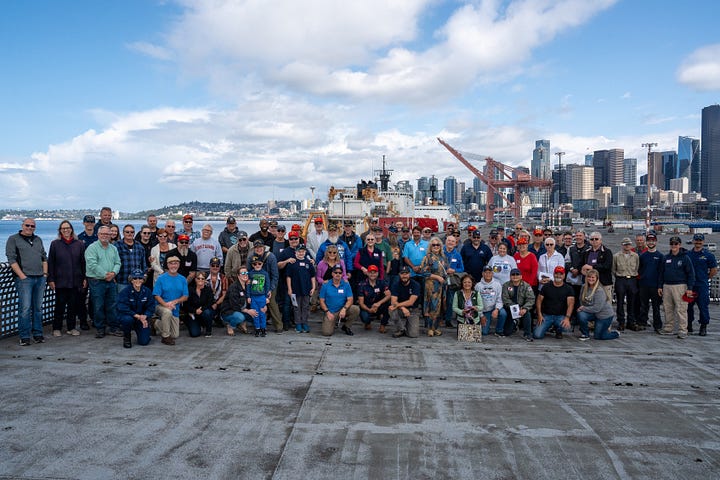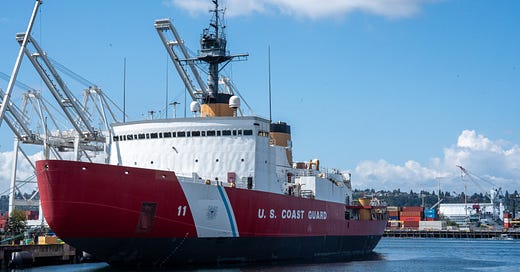U.S. Coast Guard Icebreaker Update
The Good, the Bad, and the Ugly from the past couple of months

Today, a quick round-up of news since my last updates concerning U.S. Coast Guard (USCG) icebreaking:
The Good
Healy to resume deployment
When I last wrote about the USCG, it was to note that the ‘Medium’ icebreaker Healy was returning to Seattle following a fire, likely resulting in an early end to its 2024 Arctic deployment.
On September 5th, Malte Humpert reported in gCaptain that initial repairs to Healy are complete, and she will return to “the U.S. Arctic region” on or about October 1st. According to the article, this voyage will face some restrictions:
Healy’s late fall patrol will be limited to ice-free waters and seas with marginal ice coverage no higher than 70 percent first-year ice. The Pacific Area Cutter Forces did not specify the reasoning for the operational limitations. The onboard fire reportedly destroyed an engine room transformer rendering the starboard shaft unusable.

Polar Star returns to Seattle
The USCG’s ‘Heavy’ icebreaker Polar Star arrived in Seattle on August 25, 2024. According to a USCG press release, she had been away from Seattle for 285 days- 138 supporting the re-supply of McMurdo Station in Antarctica (Operation Deep Freeze) followed by a drydock period at Mare Island in Vallejo, California. While in drydock, she completed the fourth phase of a five-year Service Life Extension Program (SLEP):
Phase four of Polar Star’s SLEP took place over approximately 140 days and represented a total investment of $16.8 million. By replacing outdated and maintenance-intensive equipment, the Coast Guard will mitigate lost mission days caused by system failures and unplanned repairs. The contracted SLEP work items and recurring maintenance is taking place within a five-year, annually phased production schedule running from 2021 through 2025.
The Coast Guard is investing in a new fleet of polar security cutters (PSC) that will sustain the service’s capabilities to meet mission needs in both the Arctic and Antarctic regions. The SLEP allows Polar Star to continue providing access to the Polar regions until the PSCs are operational and assume the high latitude missions.
For the past several years, this has been Polar Star’s cycle: Depart in November to Support Operation Deep Freeze, enter drydock in April for repair and life extension, and then return to Seattle until Operation Deep Freeze. Polar Star did make a rare Arctic patrol in 2020-2021, as Deep Freeze was cancelled due to COVID restrictions.
It is good that the aging Polar Star is once again available and that Healy, despite early reporting saying otherwise, will be able to return to the Arctic this year.
The Bad
CBO cost estimate
The Congressional Budget Office (CBO) released its report, The Cost of the Coast Guard’s Polar Security Cutter, in August. The conclusion of the report is not a surprise, as Dr. Eric Labs previewed the report during his April congressional testimony (which I covered here). Here is the main finding:
Using its own weight-based cost model, CBO estimates that the first PSC would cost $1.9 billion in 2024 dollars. Subsequent ships would average about $1.6 billion each. Given those estimates, the three-ship PSC program would cost $5.1 billion—about 60 percent more than the Coast Guard’s current estimate.
The USCG is due to report its own revised cost and timeline estimates for the PSC by the end of the year.
GAO Report: Lack of Metrics on Arctic Operations
The Government Accountability Office (GAO) released a report titled Coast Guard: Complete Performance and Operational Data Would Better Clarify Arctic Resource Needs on August 13th. It has two primary findings. The first concerns the USCG’s failure to track current resource use and mission performance in the Arctic:
The Coast Guard manages Arctic risks like responding to maritime incidents by forward deploying cutter and aviation assets into the U.S. Arctic region to reduce its transit and response times. The Coast Guard also deploys assets to provide a presence there but has not always been able to meet its planned deployment commitments recently. Coast Guard reports for the region that document asset resource use and mission performance for operational planning did not have complete information from fiscal year 2016 through fiscal year 2021. For example, some years did not include targets for key missions (e.g., maritime law enforcement). Reports were also unavailable for fiscal years 2022 and 2023. Collecting and reporting complete information would better position the Coast Guard to make more informed operational planning decisions for the region.
The second finding relates to how the USCG intends to track the implementation of its strategic objectives for the Arctic, including those identified in its own Arctic strategy that support the national Arctic strategy. According to the GAO:
Additionally, the Coast Guard Arctic implementation plan outlines initiatives and actions that it intends to take to execute strategic objectives identified in its Arctic strategy and to support the national Arctic strategy. However, the plan generally does not include key metrics such as performance measures, targets, or time frames for action items. This may make it difficult for the Coast Guard to plan activities, determine resource needs, assess its progress toward strategic objectives, and ensure its efforts are aligned with national efforts.
The USCG’s own Arctic Strategy has ninety-seven action items in support of fourteen initiatives. But none of these action items have performance measures or targets, and only five have any time frame description at all for accomplishment. GAO recommended that they add performance measures with associated targets and timeframes for all of these action items. Although the USCG concurred with the recommendation, it said that it would incorporate appropriate milestones into its programs in support of these action items, not for the action items themselves. Its supporting action item metrics would then be tracked and reported to USCG leadership as needed.
The GAO does not consider that sufficient, and I can see why. It is normally the metrics and timeframe of the high-level action items that drive the deadlines and metrics of the tasks that support them.
We maintain that including performance measures with associated targets and time frames for its Arctic implementation plan action items could help the Coast Guard coordinate its Arctic efforts more effectively and better inform related resource requests.
Goals without metrics… Sounds familiar.
The Ugly: Negative design progress?
According to the August CBO report (referenced above), as of July 2024 the Polar Security Cutter design is 59% complete.
However, back in May Ms. Shelby Oakly of the Government Accountability Office (GAO) said in testimony before Congress that the PSC design was 67% complete.
I’m not sure how this happened- additional re-design required? The numbers cited are wrong, or refer to different metrics? As the PSC is one of the USCG’s top two priorities, I would hope that officials would have these numbers at their fingertips. Regardless of the reason for the seemingly downward trend, this is not a good sign.
(h/t Malte Humpert at gCaptain)
Other news:
Aiviq to be homeported in Juneau, Alaska
According to an August 14 USCG press release:
The U.S. Coast Guard announced Wednesday it will homeport a commercially procured icebreaker in Juneau.
The Coast Guard is acquiring the Aiviq, a U.S. registered ship originally built to serve as an Arctic oil-exploration support vessel, which has an icebreaking capability sufficient to serve as a Coast Guard medium polar icebreaker, following modification….
The Coast Guard was appropriated $125 million in fiscal year 2024 to purchase a commercially available icebreaker. Currently, the Aiviq is the only U.S. built commercial vessel meeting necessary icebreaking standards. The Service anticipates the vessel will reach initial operational capability in two years.
The USCG has been saying for months now that it is acquiring the Aiviq. I’m beginning to wonder when the actual purchase will occur.
Polar Sea moves to Suisun Bay, California
Seattle said farewell to the Polar Star’s sister ship, the Polar Sea during a gathering on August 27th, just before she left en route to the Naval Reserve Fleet in Suisun Bay, California. Polar Sea has been out of service since suffering a major engineering casualty in 2010. She’s been maintained in service only as a source of spare parts for the Polar Star.


According to the USCG, as reported to latitude38 :
Coast Guard Cutter Polar Sea arrived at Mare Island Dry Dock on September 5, 2024. Following a brief dry dock for cleaning and inspection, the ship will be moved to the United States Naval Reserve Fleet in Suisun Bay, CA to facilitate ongoing Coast Guard shore infrastructure investments at its previous berthing at Coast Guard Base Seattle. That major project includes pier construction and dredging to support Polar Security Cutters and other major cutters. CGC Polar Sea will still be accessible to the Coast Guard in supporting the continued operation of CGC Polar Star.
Every so often, someone suggests returning the Polar Sea to service in order to bolster the USCG icebreaking fleet. This move should put an end to that idea.
Suisun is close to Mare Island, where Polar Star is drydocked each year following Operation Deep Freeze; Polar Sea can now more easily support this maintenance with parts, if she has anything left to give.
Congressional Research Service (CRS) Report Update
CRS released an update to the Coast Guard Polar Security Cutter (Polar Icebreaker) Program: Background and Issues for Congress on August 22nd. Updated information includes:
The U.S. Coast Guard intends to homeport the Aiviq in Juneau, Alaska
Adds a section describing the Icebreaker Collaboration Effort (ICE) Pact
Adds a reference to the August 2024 CBO Report discussed earlier
Suggests that Congress might consider how, if at all, the possibility of building polar icebreakers in a foreign shipyard might be affected by the ICE Pact
Adds a section on the FY 2025 DHS Appropriations Act and removes information about the 2024 Act
Closing Thoughts:
Beside Healy’s repair and planned return to the Arctic, there has been very little new information concerning USCG icebreakers since my previous reports.
The CBO report on metrics is concerning. Despite all of the focus on the Arctic and Arctic strategy during the past five years, it appears that the USCG is unable to provide metrics on how well it is accomplishing its required tasks in this key region. Not only that, but it appears that there will be no overall metrics or timelines associated with its high-level Arctic Strategy Implementation Plan (ASIP). Metrics will be at a lower task level and only available to USCG leadership. I don’t understand this, unless they wanted to hide a lack of progress, similar to how the USCG has reported on the PSC program over the past few years.
For the moment, though, we are still waiting for some important updates: the USCG owes Congress its own updated PSC program timeline and cost update before the end of this year. At the same time, the USCG pledged to begin actual construction of the first PSC before the end of this year (seemingly without regard to design progress). And more ICE Pact details are due by the end of this year, including a signed memorandum of understanding.
With so much information due in the coming months, subscribing is the best way to ensure that you stay current on the news and its wider implications. Consider sharing with a friend, work colleague, or family member; it takes me some time to research and write these articles, so I’m happy to see them spread far and wide. It’s important to keep this conversation going.
Until next time.
All the Best,
PGR






What are your thoughts on the ongoing development of the research-focused icebreaker?